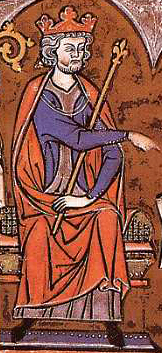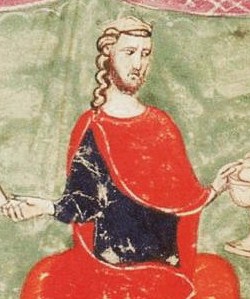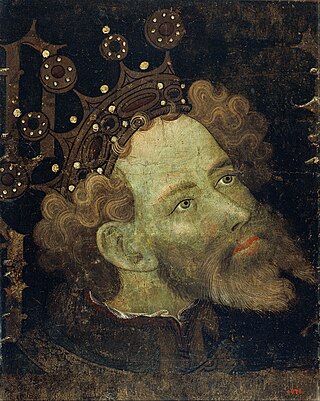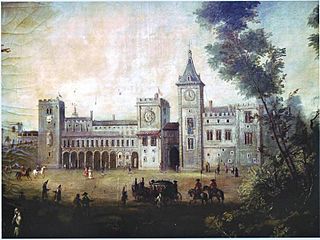
Alfonso IV, called the Kind, was King of Aragon and Count of Barcelona from 1327 to his death. His reign saw the incorporation of the County of Urgell, Duchy of Athens, and Duchy of Neopatria into the Crown of Aragon.

James I the Conqueror was King of Aragon, Count of Barcelona, and Lord of Montpellier from 1213 to 1276; King of Majorca from 1231 to 1276; and King of Valencia from 1238 to 1276. His long reign of 62 years is not only the longest of any Iberian monarch, but one of the longest monarchical reigns in history, ahead of Hirohito but remaining behind Queen Elizabeth II, Queen Victoria, and Ferdinand III of Naples and Sicily.

Peter III of Aragon was King of Aragon, King of Valencia, and Count of Barcelona from 1276 to his death. At the invitation of some rebels, he conquered the Kingdom of Sicily and became King of Sicily in 1282, pressing the claim of his wife, Constance II of Sicily, uniting the kingdom to the crown.

Peter IV, called the Ceremonious, was from 1336 until his death the king of Aragon, Sardinia-Corsica, and Valencia, and count of Barcelona. In 1344, he deposed James III of Majorca and made himself King of Majorca.

Martin the Humane, also called the Elder and the Ecclesiastic, was King of Aragon, Valencia, Sardinia and Corsica and Count of Barcelona from 1396 and King of Sicily from 1409. He failed to secure the accession of his illegitimate grandson, Frederic, Count of Luna, and with him the rule of the House of Barcelona came to an end.

This is a list of the counts of Urgell, a county of the Principality of Catalonia in the 10th through 13th centuries.

Ferdinand I named Ferdinand of Antequera and also the Just was king of Aragon, Valencia, Majorca, Sardinia and (nominal) Corsica and king of Sicily, duke (nominal) of Athens and Neopatria, and count of Barcelona, Roussillon and Cerdanya (1412–1416). He was also regent of Castile (1406–1416). He was the first Castillian ruler of the Crown of Aragon.

The 1412 Compromise of Caspe was an act and resolution of parliamentary representatives of the constituent realms of the Crown of Aragon, meeting in Caspe, to resolve the interregnum following the death of King Martin of Aragon in 1410 without a legitimate heir.
This is a timeline of notable events during the period of Muslim presence in Iberia, starting with the Umayyad conquest in the 8th century.

The Kingdom of Valencia, located in the eastern shore of the Iberian Peninsula, was one of the component realms of the Crown of Aragon.

The Revolt of the Brotherhoods was a revolt by artisan guilds (Germanies) against the government of King Charles V in the Kingdom of Valencia, part of the Crown of Aragon. It took place from 1519–1523, with most of the fighting occurring during 1521. The Valencian revolt inspired a related revolt in the island of Majorca, also part of Aragon, which lasted from 1521–1523.

The coat of arms of the Valencian Community is the official emblem of the self-government institutions of the Valencian Community. It is based on the armorial achievement used from the reign of King Peter IV to John II, called the Great. In 1978 the former Council of the Valencian Country approved it “...for being the oldest known representative emblem of the former Kingdom of Valencia, that had located on the Xerea Gate of the city of Valencia”.

James II was the Count of Urgell (1408–1413), Viscount of Àger, and lord of Antillón, Alcolea de Cinca, and Fraga. Scion of a younger branch of the House of Barcelona and its last male member, he was the centre of opposition to the House of Trastámara after it succeeded to the Crown of Aragon in 1412.
The Union of Valencia was an anti-royalist movement in the Kingdom of Valencia begun in 1283 and lasting into the fifteenth century. The Union was formed in the aftermath of the formation of the Union of Aragon in October 1283. Its essential purpose was as a tool of the Valencian nobility to be used against the influence of Catalans and foreigners on the actions of the Crown. By 1285 the Unions had severely curtailed the powers of the king and were hindering his efforts in the War of the Sicilian Vespers and against the Aragonese Crusade that invaded Catalonia that year.
The Battle of Épila was fought on July 21, 1348, near Zaragoza, in what is now Spain, between the supporters of the Union of Aragon and King Peter IV, led by Don Lope de Luna. This battle was the culmination of a long confrontation between a large segment of the nobility and the people of Aragon against the king, ending with the decisive defeat of the Union.

The Battle of Paterna took place between the troops of the Kingdom of León, under the command of Ferdinand I of León and Castile, and those of the Taifa of Valencia, commanded by Abd al-Malik ibn Abd al-Aziz al-Muẓaffar. The battle occurred at the same time as the Siege of Valencia, resulted in a victory for the Kingdom of León.

The now demolished Del Real Palace or Royal Palace was the former residence of the kings of Valencia in the «Cap i Casal» of the kingdom, as the city of Valencia was then called. It was on the left bank of the Turia River, where nowadays Jardines del Real are. It was also known as «300 keys palace» in reference to the number of rooms it had at its height.

Enrique de Aragón y Pimentel, known as el Infante Fortuna, was Count of Ampurias becoming Count later 1st Duke of Segorbe.
The Count of Urgell's revolt was a military uprising led by James II, Count of Urgell against king Ferdinand I of Aragón in June 1413 as a result of the disagreement with the result of the Compromise of Caspe, to which James presented himself as a candidate to succeed the king of Aragón Martin I, in which the final decision of the delegates, made public on June 28 of the previous year, was not favorable.

The conquest of Valencia by the Catalan and Aragonese troops of King James I of Aragon took place on 9 October 1238.
















